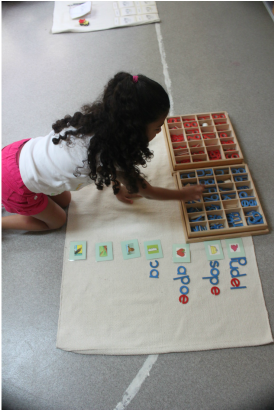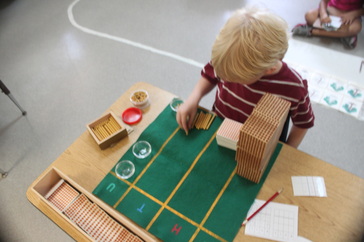Twin Rivers Montessori Academy: Our Curriculum

Dr. Maria Montessori (1870-1952) was the first woman to graduate from the University of Rome. She developed the method of education that bears her name while scientifically observing how children learn and develop.
Her observations led her to the following conclusions:
-Children learn best by doing, not just watching and listening.
-Montessori materials are designed to sharpen sensory perception and muscular control.
-Lessons emphasize only one facet of learning at a time, so children do not feel overwhelmed.
-Lessons consist of a series of operations that must be done in a specific sequence.
-Children must have opportunities to choose their own work.
-Many exercises are self-correcting, allowing children to work independently.
-A lesson must be completed before another is begun which teaches perseverance.
-Children have "sensitive periods" when they are especially receptive to certain subjects.
Her observations led her to the following conclusions:
-Children learn best by doing, not just watching and listening.
-Montessori materials are designed to sharpen sensory perception and muscular control.
-Lessons emphasize only one facet of learning at a time, so children do not feel overwhelmed.
-Lessons consist of a series of operations that must be done in a specific sequence.
-Children must have opportunities to choose their own work.
-Many exercises are self-correcting, allowing children to work independently.
-A lesson must be completed before another is begun which teaches perseverance.
-Children have "sensitive periods" when they are especially receptive to certain subjects.

An article from the American Montessori Society regarding the benefits of a Montessori education is listed below. The full article source is noted on the bottom of the article.
Source: http://amshq.org/Montessori-Education/Introduction-to-Montessori/Benefits-of-Montessori
- Each child is valued as a unique individual. Montessori education recognizes that children learn in different ways, and accommodates all learning styles. Students are also free to learn at their own pace, each advancing through the curriculum as he or she is ready, guided by the teacher and an individualized learning plan.
- Beginning at an early age, Montessori students develop order, coordination, concentration, and independence. Classroom design, materials, and daily routines support the individual’s emerging “self-regulation” (ability to educate one’s self, and to think about what one is learning), toddlers through adolescents.
- Students are part of a close, caring community. The multi-age classroom—typically spanning 3 years—re-creates a family structure. Older students enjoy stature as mentors and role models; younger children feel supported and gain confidence about the challenges ahead. Teachers model respect, loving kindness, and a belief in peaceful conflict resolution.
- Montessori students enjoy freedom within limits. Working within parameters set by their teachers, students are active participants in deciding what their focus of learning will be. Montessorians understand that internal satisfaction drives the child’s curiosity and interest and results in joyous learning that is sustainable over a lifetime.
- Students are supported in becoming active seekers of knowledge. Teachers provide environments where students have the freedom and the tools to pursue answers to their own questions.
- Self-correction and self-assessment are an integral part of the Montessori classroom approach. As they mature, students learn to look critically at their work, and become adept at recognizing, correcting, and learning from their errors.
Source: http://amshq.org/Montessori-Education/Introduction-to-Montessori/Benefits-of-Montessori
The Montessori classroom is separated into five areas of learning:
1. Language
2. Mathematics
3. Sensorial
4. Geography and Cultural Studies
5. Practical Life
1. Language
2. Mathematics
3. Sensorial
4. Geography and Cultural Studies
5. Practical Life
Children are exposed to a rich variety of experiences in the three to six class since children at this age learn easier and more efficiently than at any other time of life.
The classroom is equipped with beautiful, age appropriate materials that are easily accessible on low, open shelves that are convenient for small children. The child has the freedom to choose work that has been presented by the teacher, and this environment invites the child to explore, which helps build social and academic skills.
The classroom is equipped with beautiful, age appropriate materials that are easily accessible on low, open shelves that are convenient for small children. The child has the freedom to choose work that has been presented by the teacher, and this environment invites the child to explore, which helps build social and academic skills.